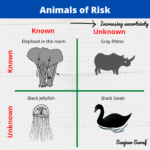Citizens often oppose chemical process facilities near their community because of potential for high consequence events. This risk aversion of society is commonly referred to as NIMBY (Not-in-my-backyard). The risk aversion is based not by taking into account annual fatalities but based on potential worst-case catastrophe. Thus the main factor influencing risk perception is catastrophic consequence potential.
Any logical person would agree that risks from chemical plants should be based on prudent evaluations and not on misconceived public outrage. However educating public about risks of chemical processing has often proven fruitless since an expert’s basis of risk is different than that of a layman. The expert often focuses comparing potential annualized fatalities whereas the community members are focused on comparing just severity of the potential worst-case catastrophe. Aligning public opinion with that of the expert is unlikely because the public generally ignores the low probabilities associated with such potential worst-case catastrophes.
Thus risk communication is extremely important since it influences risk perception. There are certain well-proven techniques based on social behavior that one can use to successfully communicate risks. In the later posts, I will discuss how to communicate risks effectively else NIMBY will soon transform into BANANA – Build Absolutely Nothing Anywhere Near Anyone.



